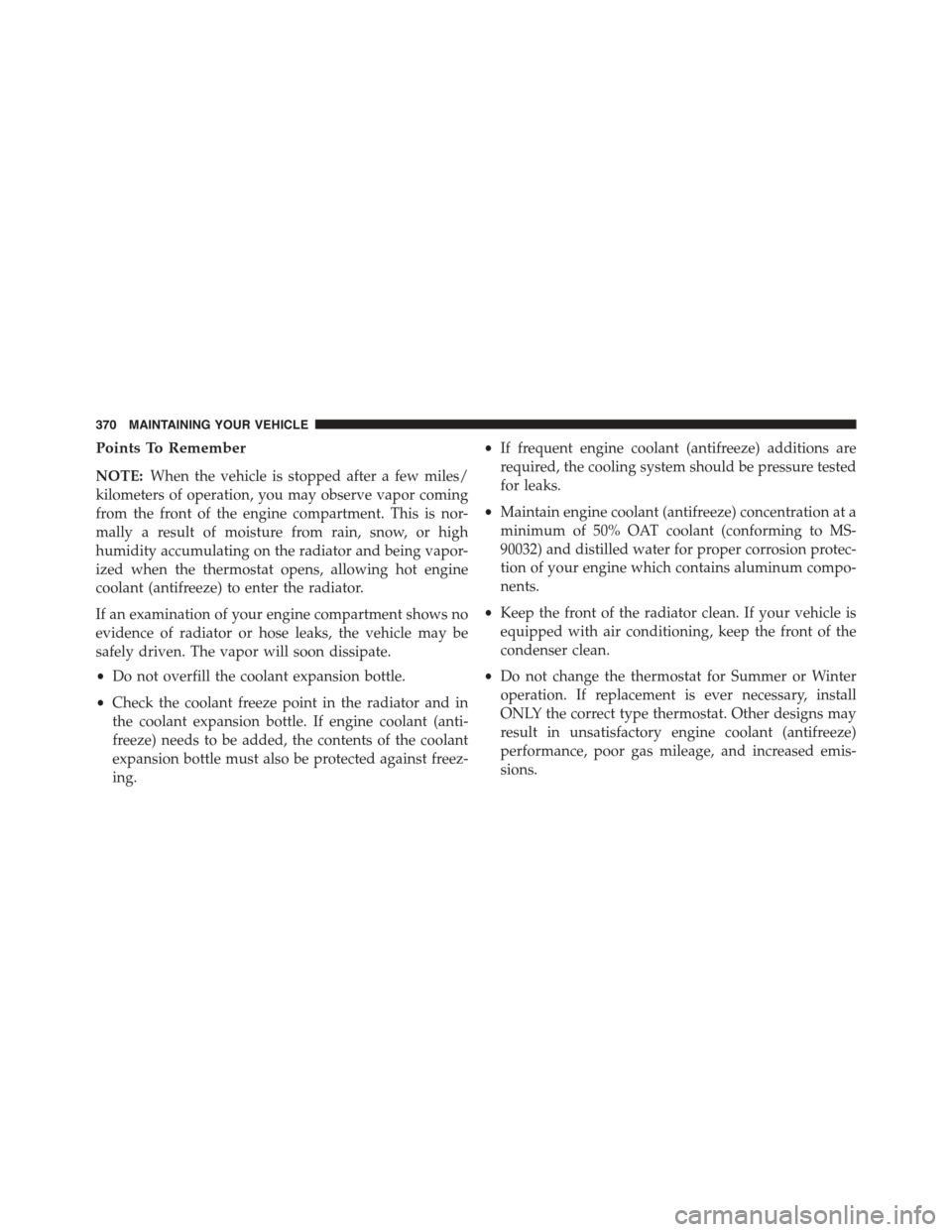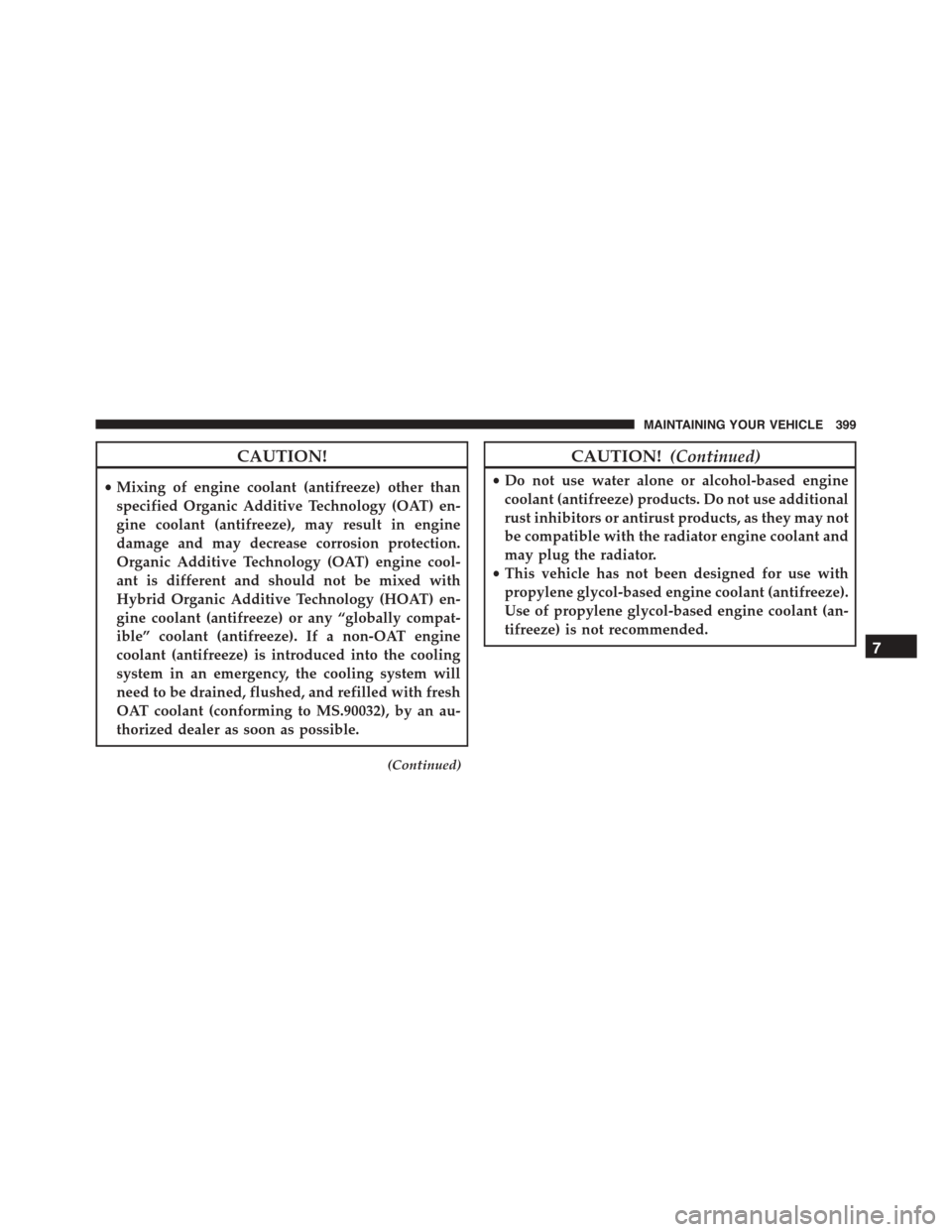Page 372 of 438

Points To Remember
NOTE:When the vehicle is stopped after a few miles/
kilometers of operation, you may observe vapor coming
from the front of the engine compartment. This is nor-
mally a result of moisture from rain, snow, or high
humidity accumulating on the radiator and being vapor-
ized when the thermostat opens, allowing hot engine
coolant (antifreeze) to enter the radiator.
If an examination of your engine compartment shows no
evidence of radiator or hose leaks, the vehicle may be
safely driven. The vapor will soon dissipate.
•Do not overfill the coolant expansion bottle.
•Check the coolant freeze point in the radiator and in
the coolant expansion bottle. If engine coolant (anti-
freeze) needs to be added, the contents of the coolant
expansion bottle must also be protected against freez-
ing.
•If frequent engine coolant (antifreeze) additions are
required, the cooling system should be pressure tested
for leaks.
•Maintain engine coolant (antifreeze) concentration at a
minimum of 50% OAT coolant (conforming to MS-
90032) and distilled water for proper corrosion protec-
tion of your engine which contains aluminum compo-
nents.
•Keep the front of the radiator clean. If your vehicle is
equipped with air conditioning, keep the front of the
condenser clean.
•Do not change the thermostat for Summer or Winter
operation. If replacement is ever necessary, install
ONLY the correct type thermostat. Other designs may
result in unsatisfactory engine coolant (antifreeze)
performance, poor gas mileage, and increased emis-
sions.
370 MAINTAINING YOUR VEHICLE
Page 399 of 438
FLUID CAPACITIES
U.S.Metric
Fuel (Approximate)13.1 Gallons50 Liters
Engine Oil with Filter
1.4L Turbo Engine4 Quarts3.8 Liters
Cooling System
1.4 Liter Turbo Engine (MOPAR®
Antifreeze/Engine Coolant 10
Year/150,000 Mile Formula).
6.1 Quarts5.8 Liters
7
MAINTAINING YOUR VEHICLE 397
Page 401 of 438

CAUTION!
•Mixing of engine coolant (antifreeze) other than
specified Organic Additive Technology (OAT) en-
gine coolant (antifreeze), may result in engine
damage and may decrease corrosion protection.
Organic Additive Technology (OAT) engine cool-
ant is different and should not be mixed with
Hybrid Organic Additive Technology (HOAT) en-
gine coolant (antifreeze) or any “globally compat-
ible” coolant (antifreeze). If a non-OAT engine
coolant (antifreeze) is introduced into the cooling
system in an emergency, the cooling system will
need to be drained, flushed, and refilled with fresh
OAT coolant (conforming to MS.90032), by an au-
thorized dealer as soon as possible.
(Continued)
CAUTION!(Continued)
•Do not use water alone or alcohol-based engine
coolant (antifreeze) products. Do not use additional
rust inhibitors or antirust products, as they may not
be compatible with the radiator engine coolant and
may plug the radiator.
•This vehicle has not been designed for use with
propylene glycol-based engine coolant (antifreeze).
Use of propylene glycol-based engine coolant (an-
tifreeze) is not recommended.
7
MAINTAINING YOUR VEHICLE 399
Page 405 of 438
•Check the tire inflation pressures and look for unusual
wear or damage.
•Check the fluid levels of the coolant reservoir, and
brake master cylinder reservoir, and fill as needed.
•Check function of all interior and exterior lights.
Required Maintenance Intervals.
Refer to the maintenance schedules on the following
page for the required maintenance intervals.
At Every Oil Change Interval As Indicated By Oil
Change Indicator System:
•Change oil and filter.
•Rotate the tires.Rotate at the first sign of irregu-
lar wear, even if it occurs before the oil indicator
system turns on.
At Every Oil Change Interval As Indicated By Oil
Change Indicator System:
•Inspect battery and clean and tighten terminals as
required.
•Inspect brake pads, shoes, rotors, drums, and
hoses.
•Inspect engine cooling system protection and
hoses.
•Check and adjust hand brake.
•Inspect exhaust system.
•Inspect engine air cleaner if using in dusty or
off-road conditions.8
MAINTENANCE SCHEDULES 403
Page 425 of 438

Cooling System...........................365
Adding Coolant (Antifreeze)...............367
Coolant Level..........................365
Disposal of Used Coolant.................369
Drain, Flush, and Refill...................365
Inspection............................369
Points to Remember.....................368
Pressure Cap..........................368
Selection of Coolant (Antifreeze).............366
Corrosion Protection.......................377
Cruise Light.............................167
Cupholders.............................150
Customer Assistance.......................410
Data Recorder, Event.......................60
Daytime Running Lights....................113
Dealer Service............................349
Deck Lid, Emergency Release.................30
Defroster, Windshield.......................85
Diagnostic System, Onboard.................348
Dipsticks
Automatic Transmission..................376
Disposal
Antifreeze (Engine Coolant)................369
Door Locks..............................22
Door Opener, Garage.......................136
Downshifting............................228
Driving
Through Flowing, Rising, or Shallow Standing
Water................................252
Electrical Outlet, Auxiliary (Power Outlet)........147
Electrical Power Outlets.....................147
Electric Remote Mirrors......................95
Electronic Brake Control System...............257
Brake Assist System.....................259
Electronic Roll Mitigation (ERM)..............265
Electronic Speed Control (Cruise Control)........123
10
INDEX 423
Page 426 of 438

Electronic Stability Control (ESC)..............262
Electronic Vehicle Information Center (EVIC)......134
Exit Trip..............................182
Start Of Trip Procedure...................182
Emergency Deck Lid Release..................30
Emergency, In Case of
Hazard Warning Flasher..................311
Jacking...............................324
Jump Starting..........................332
Towing..............................340
Emergency Trunk Release....................30
Engine
Air Cleaner...........................352
Break-In Recommendations.................82
Checking Oil Level......................350
Compartment..........................347
Cooling..............................365
Exhaust Gas Caution.....................84
Fails to Start...........................226
Flooded, Starting.......................226
Fuel Requirements......................299
Oil . . . . . . . . . . . . . . . . . . . . . . . . . . . . . . . . ..350
Oil Filler Cap..........................351
Oil Selection...........................351
Overheating...........................311
Starting..............................224
Temperature Gauge......................169
Enhanced Accident Response Feature............55
Euro Twin Clutch Transmission...............229
Fluid Type............................374
Gear Ranges...........................233
Event Data Recorder........................60
Exhaust Gas Caution........................84
Exhaust System...........................84
Exterior Lights............................87
Filler Location Fuel........................169
424 INDEX
Page:
< prev 1-8 9-16 17-24